© 2006-2020 - All Rights Reserved
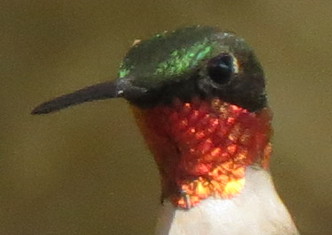
There are a great variety of hummingbird species found around Utopia. Here we try to show and discuss them a bit. These pictures are mostly poor, but we hope they serve illustrative purposes, and give an idea of the magic of hummingbirds. We have updated the page a few times, adding photos or text about the status and ID (July 2011, most recently in Oct. 2019).
~ ~ ~
Hummingbirds, often called 'hummers' by birders, are fast, beautiful, fascinating, easy to see closely, and so great birds to watch. Males have iridescent feathers in the throat called a gorget that can be spectacular when seen in the right light (over the shoulder best), but they just appear dark when not refracting light to viewer's angle.

They can shine like neon at the right angle
When available some 90% of their diet is small bugs, often gathered at flowers (it's not just nectar they are there for) and they are great pollinators. You can often see them 'flycatching' though gnatcatching is more like it. The numbers of individuals locally can be staggering, we had a thousand plus individuals daily at our 8 feeders on Seco Ridge, consuming over a gallon of fluid and 2+ lbs. of sugar daily! Hummingbirds are driving the price of sugar up! :)
The payoff is, besides the intimate study opportunities, and the entertainment, you might attract a stray vagrant rarity, by having all the gang over for lunch regularly. Like any and all birds, the best way to find something rare is to learn your regular common stuff so when something unusual shows up, it stands out to you. Either write a description while looking at it, or better, take a picture.
The last thing in the world you want to do is to try to explain something like this to experts:

hybrid Black-chinned x Ruby-throated Hummingbird
If you see something odd, unusual, or different, besides letting me know if you are local please, note bill color if any, tail pattern, and head and throat pattern. Over 99% of what is here is Black-chinned or Ruby-throated, so learning them first is the key to identifying anything else here.

From Lost Maples to Utopia, that is, in the upper Sabinal River drainage, a whopping 13 species of hummingbirds have occurred, which is outstanding diversity in the U.S.. In our (former) yard on Seco Ridge in 6 years I saw 11 species! The overwhelming majority of what is here though is Black-chinned Hummingbird, the abundant breeder mostly present March through August. Ruby-throated is 2nd most common and note windows of presence. Rufous is annual in small numbers, the distant third most regular species here. Broad-tailed and Calliope are scarce but about annual in fall in very low numbers (1-2). Those are the five species pretty sure to occur here in any given year, and 99.99% of what you see here around Utopia will be one of these five.
But in that other .01%, lies the reward for good hard study. It can hardly get any more exciting than the rarities, as it seems just about anything known in the U.S. could show up. The other types that have been found here are Green (now called Mexican) Violetear (from Mexico), Blue-throated, Lucifer, Costa's, Allen's, Anna's, Broad-billed, and White-eared. But I can't buy a Buff-bellied, nearest one is a single Uvalde record in fall. Update: Bandera Co. got a Buff-bellied spring of '20 or '21. The best time for unusual things is fall, which for hummers is mostly July to October.
Remember, it only takes one good hummer to make your day. Like this one:
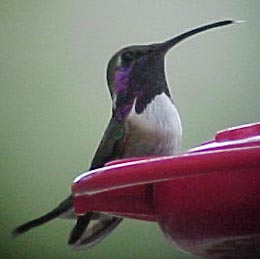
Male Lucifer Hummingbird at Seco Ridge, June 29, 2011
Maybe 11th hill country (Edw. Plt.) record, 1st Uvalde Co. record.
(couple more pix of it all the way at bottom)
Now for some hummer pix and a little bit of info about the status and identification of most of the local types.

Great form! Looks like a full-power acceleration stroke is next. This is what happens if you have too much sugar. Audubon painted some like this and people said, "they don't really do that." A great watcher far ahead of his time.
First here is the list of the 13 hummingbird species known locally.
(taken from the Bird List page)
Abbreviations: LM - Lost Maples; SR - Seco ridge; TC - N. Thunder Creek Rd.; UP - Utopia Park;
(ph.) - photographed; (a.t.) - audio taped
Green (now Mexican) Violetear - accidental in summer; LM; SR; heard at TC; May-June 2016 at Sabinal River Lodge; (ph.); (a.t.)
Broad-billed Hummingbird - accidental: LM April 09 (ph.), another March 2011
White-eared Hummingbird - accidental July 07 SR; (ph.)
Blue-throated Hummingbird - accidental at LM
Lucifer Hummingbird - accidental fall at TC; LM July 10, 2011; SR June 28- July 2, 2011 (ph.);
another was at a Century Plant Agave south of town on June 23, 2017.
Ruby-throated Hummingbird - uncommon spring, common fall; a few nest rarely;
Black-chinned Hummingbird - abundant March to August
Anna's Hummingbird - accidental in late fall 2005 two at SR - ph.; Dec. 2011 were four locally; (ph.)
Costa's Hummingbird - accidental, calling female March 4-5, 2006 at SR
Calliope Hummingbird - rare but regular in fall; TC; SR; accidental in spring at LM; (ph.);(a.t.)
Broad-tailed Hummingbird - occasional in fall; has wintered, very rare in spring, plus once in June; TC; SR; (ph.)
Rufous Hummingbird - low numbers in fall, rare in spring; very few winter; TC; SR; (ph.)
Allen's Hummingbird - very rare; a few adult males; one Mar. 2005, one Oct-Dec. 2011 at SR;
*hybrid Ruby-throated x Black-chinned (ph.)
Most Wanted and overdue: Buff-bellied Hummingbird
~ ~ ~
We'll start with the two common species. Our most common hummingbird locally is Black-chinned, the abundant breeding species present primarily March through August. This is THE baseline hummer here, as it is what most of them are. Females and immatures are the standard issue hummingbird green above and dirty white below. On both sexes the green though is somewhat dingy, dirty, muted, grayish appearing due to usually having gray edges to most of the green feathers, so they are not as bright green as Ruby-throated. Immatures at first have very contrasting gray heads so are easy to tell from the females in May and June. The bill is long, longer than head, and other than just fledged young, clearly drooped somewhat.

This is a juvenile Black-chinned, note gray head. About three waves
of these occur each year here as each new set of young fledges.
Adult females have green crown and nape.
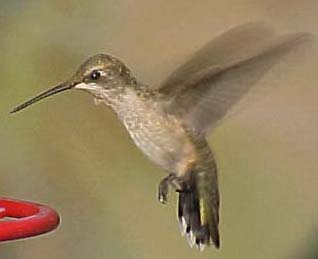
Black-chinned Hummingbird (immature or female)
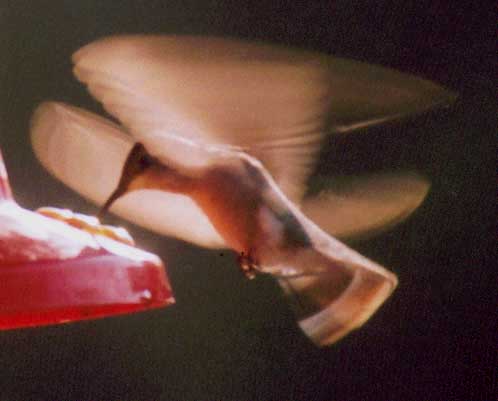
Black-chinned Hummingbird, female
A slow backlit exposure to show wing and tail movement...
this is close to how our eyes see them.
Note Black-chinned nearly constantly wags its tail.
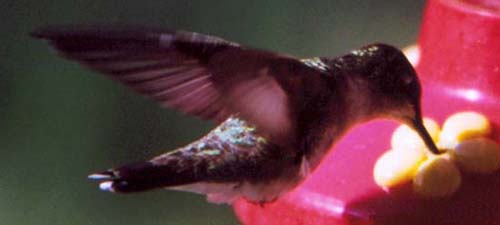
Black-chinned Hummingbird, female
A faster exposure to freeze movement
creates a different image of them.

Black-chinned Hummingbird (immature)
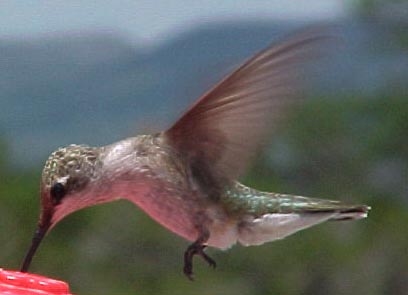
Black-chinned Hummingbird immature in late June
just acquiring first few green crown feathers.


Black-chinned Hummingbird, adult male,
usually the throat appears black.
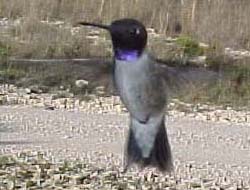

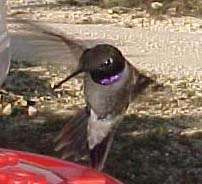
When you are lucky you get to see the purple.

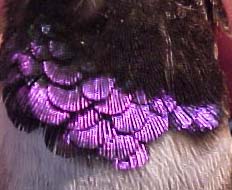
On right, a closeup of the gorget feathers.

Closeup detail of the gorget feathers.
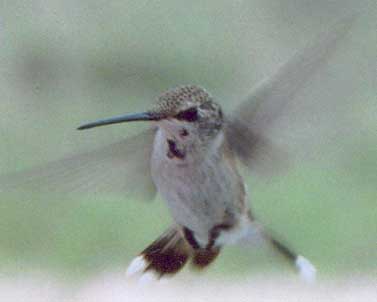
Some imm. male Black-chinned Hummingbird can start getting
some purple throat feathers in about 60 days (June),
but others may take longer.

Albino (mostly) hummingbird at Utopia July 15-18, 2011
was believed to be a Black-chinned Hummingbird (Seco Ridge).
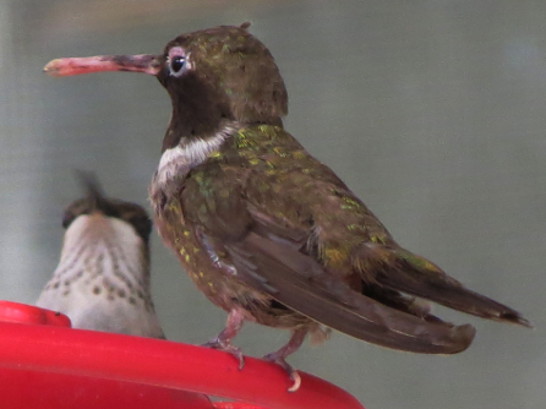
This is a sick adult male Black-chin, the bill has lost color
and the bird appears in horrible shape. It is expiring.

This one has expired. This is an adult male Black-chinned, as found.
In case you wondered how I got the gorget super closeup above...
this was my volunteer.
~ ~ ~
Ruby-throated Hummingbird occur mostly from April 15 to May 15, and again in fall from early August to October, peaking around mid-September when the first cold front passes. During August, as the Black-chinned depart, it becomes the abundant hummer here before September. While most pass through, surely a few nest here some (wet) years during the spring. Some years some are present early April to late May. I have seen birds I am sure were fresh juveniles (and still had females) in early June, more than once. Some females were banded near Leakey in May with eggs inside. Which means they weren't migrating, they were nesting and ready to lay. Note bill unlike Black-chinned is short and straight, equal to or barely longer than head length, not longer than head and drooped at tip.
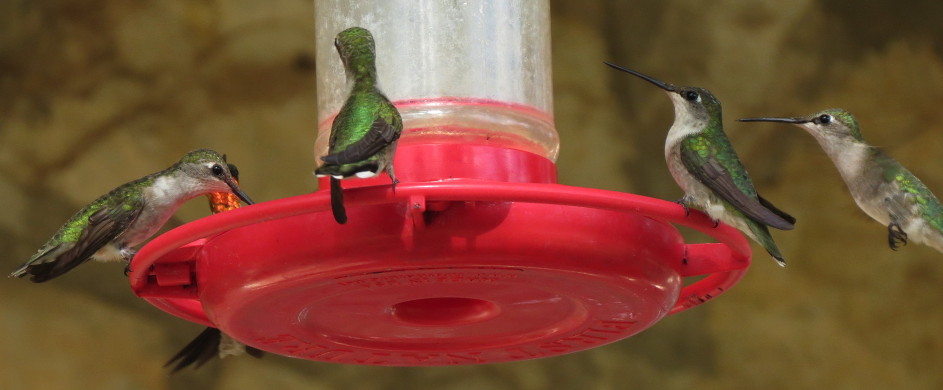
Ruby-throated Hummingbirds - females and or immature males
Green above and white below is a theme amongst female or immature hummingbirds as are some white tipped tail feathers. On Ruby-throat the bill is shorter and straighter than all but just-out-of-the-nest Black-chinned, and it lacks dirty gray feather edges of Black-chinned so is much brighter green without the dingy look.

Ruby-throated Hummingbirds - female or immature
is greener above and whiter below than Black-chinned.
Here are some adult males, no ID issues here. Much longer tailed than Black-chinned, so wing tips when at rest much further from tail tip than adult male Black-chinned (1/2" versus 1/4" in Black-chin) They are also much darker, more emerald or forest green without the dirty dingy gray cast of Black-chinned.


look at that long tail




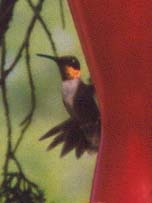

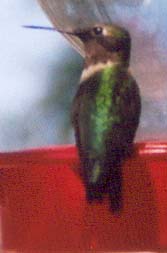

Here is an immature Ruby-throated Hummingbird being attacked by
a Praying Mantis (which appears the introduced non-native type).
I separated them (after grabbing photo - yeah I know, but...
must... get... docushot...), and the hummer flew off seemingly ok.

Male Ruby-throated Hummingbird, Sept. 12, 2019.
A little
over-exposed and burnt on the reflective part of gorget.
Rufous Hummingbird is annual, mostly in fall, mostly immature or female plumaged birds, though some adult males occur (mostly in July-Aug.).; I've seen as many as 10 Rufous here over the course of an an entire fall. It is the most likely wintering hummer here. Other than the nearly solid rufous adult males, they are green above like other hummers, but with well saturated rufous on sides, and in base of tail. Ten percent of banded Selasphorus (Rufous-Allen's types) wintering on the Texas coast are Allen's, the lookalike sibling species so a similar percentage is likely the same here. I've seen a few green-backed adult male Allen's here.
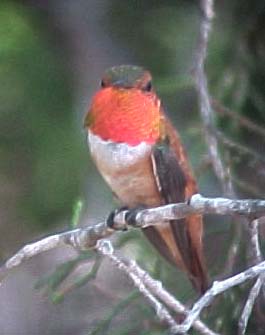
adult male Rufous Hummingbird
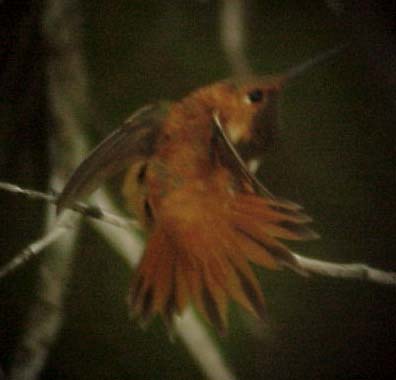
same adult male Rufous Hummingbird
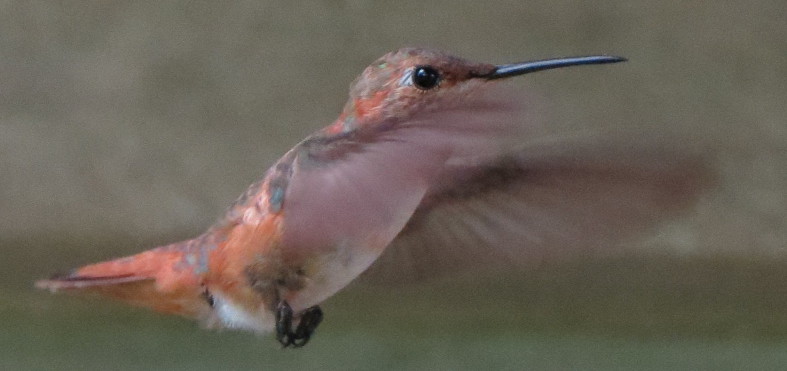
Rufous or Allen's Hummingbird - imm. or female are still
rufous below but green above.
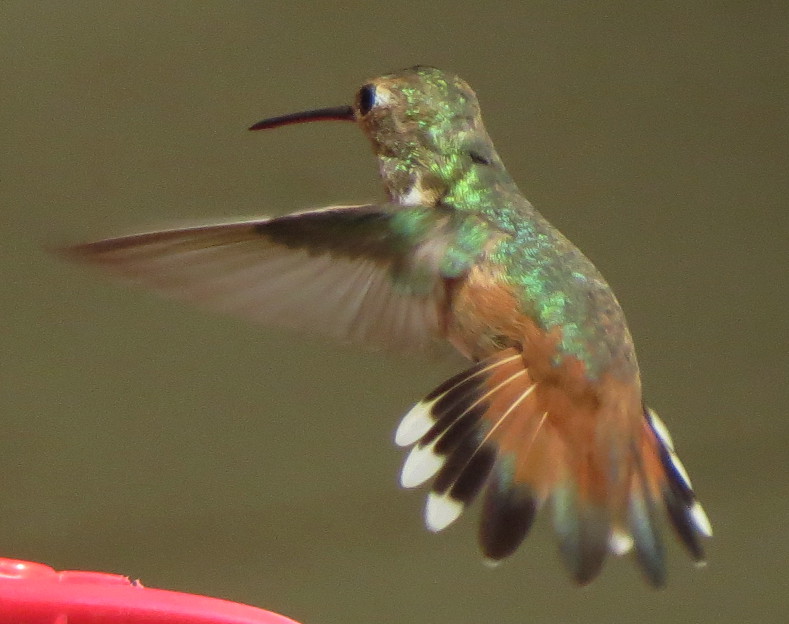
Rufous or Allen's Hummingbird
Non-adult males, that is immatures and females, are best labelled
generically as Selasphorus species unless definitive characters
are determined.
There is a record of a Rufous Hummingbird banded in Alaska, which was recaught wintering in Houston area, which was then subsequently caught again in Alaska by the same lady at the same feeders! Most hummers probably live 3-6 years if they make it past the first one. There are records though of individuals living 8, 10, and even 11 or 12 years! Many banded at wintering feeder sites are recaught for many years subsequently. Whaddabird!

Rufous Hummingbird, adult male, July 31, 2019. The iridescent gorget
feathers in throat usually appear an orangish red, but at some
light angles they can appear gold or green.

Another adult male, Sept. 29, 2019.

Here is a rear view. Rufous are smaller than the Black-chinned and
Ruby-throated but have both Ceasar and Napolean complexes to make
up for it. No one thought 6 grams could be so much piss and vinegar.
~ ~ ~

Hummingbird at Flower
In an average year one or two Calliope Hummingbird occur, most are immatures or females in fall, I know of only one spring record, an adult male April 2011 at Lost Maples, photographed by a yankee visitor and seen by all the staff and visitors for the day. I have seen a very few adult males in fall.

Calliope Hummingbird
America's smallest bird near Utopia, Sept. 05, immature or female,
note pastel peachy sides like Broad-tailed.
You can also see at the posterior end of the bird,
the gray tip of the near wing, the black area is
the tail, then the pale is the underside of the
other wingtip. Note wings extend past short tail.
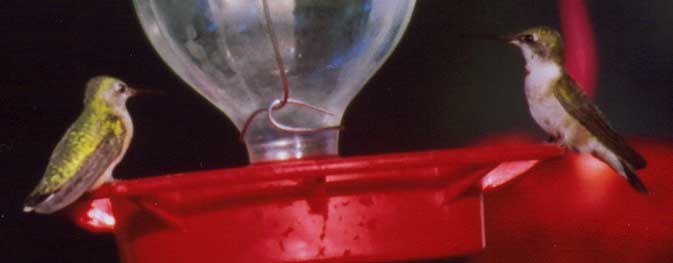
Calliope (left) and imm. male Ruby-throated Hummingbird
Then note it is smaller than a Ruby-throat, note how
long even an immature male Ruby-throat tail is past wings.
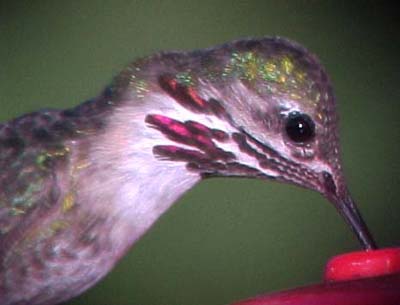
Adult male Calliope Hummingbird at Seco Ridge Aug 21, 2009.
Over 90+% of those that occur here are immatures or females.
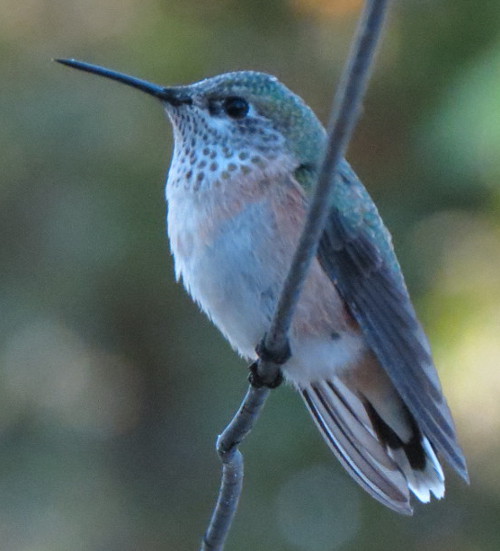
Calliope Hummingbird, one of two at our feeders Aug. 30, 2020. Note wings extend past the very short tail, bill is short as the head, pale peachy sides. Has a nice soft chip note too. America's smallest bird at 3.25", and up close they don't seem that big. This is probably an immature male.
On average I see about one or two Broad-tailed Hummingbird per year, but have had four in a single fall, and, it has wintered here.
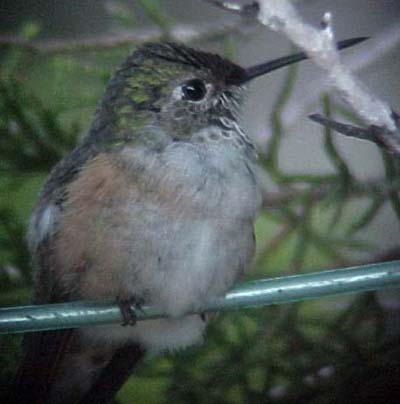
Immature Broad-tailed Hummingbird note pastel peach-buff sides, not saturated like Rufous or Allen's.
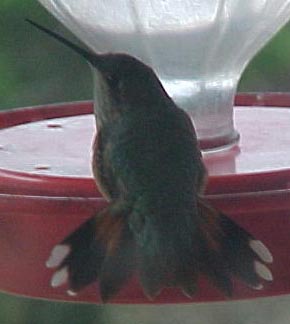
Immature male Broad-tailed Hummingbird note limited rufous in base of outer rectrices (tail feathers).
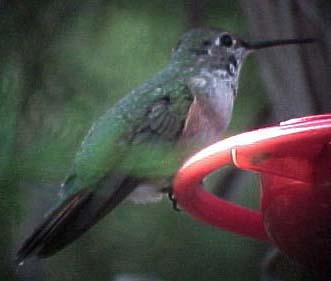
Immature Broad-tailed Hummingbird
peachy on sides, rufous in base of tail,
bright grassy green, big

Adult male Broad-tailed Hummingbird has a rose pink gorget and its wings whistle like a cricket when it flies

This is an imm. or female Broad-tailed Hummingbird Oct. 1, 2019.
Note pale pastel peachy sides and bright grassy green color above
Bigger than Ruby-throats, with a neat soft chip call note.
The following species are less than annual vagrants.
Anna's is far less than annual, I've seen it only 3 of 15 falls here. It is a late-season bird, IF it occurs at all.



Anna's Hummingbird - hatch-year male digiscoped near Utopia, Nov. 11-14, '05

Anna's Hummingbird #2 in '05, Dec. 3-9.
The gray underparts is a tip-off to look closer,
as are things like any odd (especially late) date.
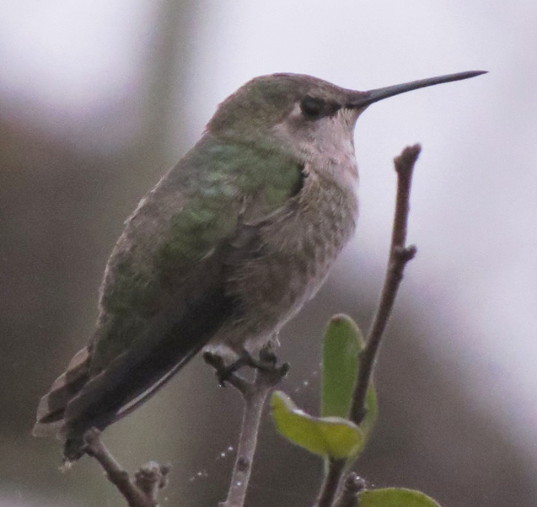
This Anna's Hummingbird was present Feb. 5 to March 1 2021,
surviving through 5-10dF lows and two 5" snow events in mid-Feb
due to constant rotating (with unfrozen) feeders for 5 days.
And for suffering through all that ......
Here is your hard earned reward!
Don't expect any of these, but knowing what might occur, and what they look like, will help you recognize something different. That is the benefit of study, you'll know when something is different, and when you better get a picture.

A female White-eared Hummingbird at Utopia, July 21-22, 2007
was 2nd hill country (Edw. Plt.) record, and 1st Uvalde Co.
record, besides the stuff yard list dreams are made of.
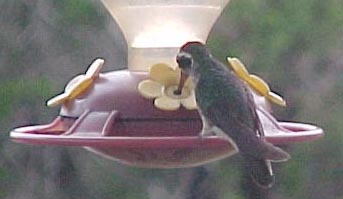
Same bird as above at Utopia, July 21-22, 2007.
A thousand dollar bird on a $3.95 feeder.
Then this was a 5 day wonder June 28 to July 2, 2011 (though surely it was present the morning of July 3)
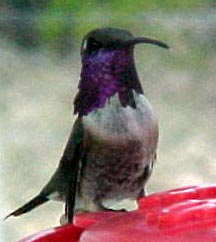

Male Lucifer Hummingbird at Utopia July 1, 2011

same male Lucifer Hummingbird, June 29, 2011 It doesn't get much better than a good hummer!
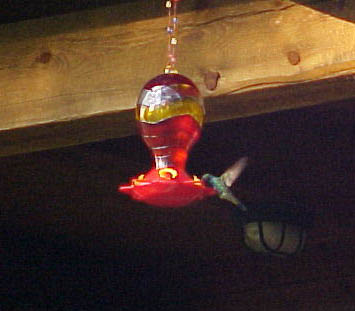
Green Violetear June 8, 2016 at Sabinal River Lodge
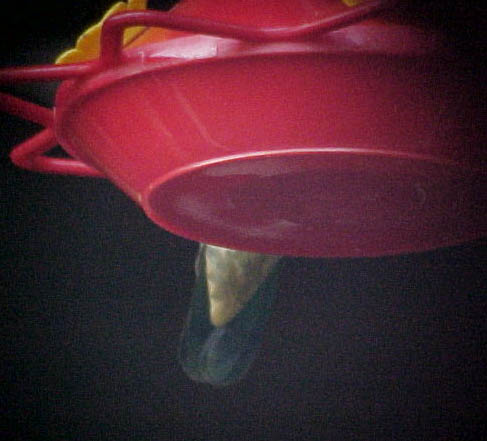
The undertail of same Green Violetear June 9, 2016
~ ~ ~ summary ~ ~ ~
Whooda thunk you could essentially throw a dart at a random spot here, where every acre looks like a billion next to it, put out some feeders, and attract 11 species of hummingbirds in about 7 years? White-eared and Lucifer at the same place!?! On the plateau? Green Violetear was an expected vagrant. A female Costa's was the best one, though presumedly rejected or maybe unreviewed by the TBRC since I had no irrefutable evidence, just a written description. Yeah I blew it not getting tape of a call I've heard thousands of times over 50 years. I thought it would stay more than 2 days. And probably would not have noticed it if it had not been vocalizing alot.
The big message is that there simply must be a lot more going through than what one person sees at one randomly placed feeder bank. The only thing different about the Seco Ridge site is there was a nature nerd there that knows them fairly well for eight years watching closely. Since 2013 we are down along the river habitat corridor on the valley floor. Might have been more hummers moving up on the ridge? Or maybe there are more folks with feeders along the river so they are spread out more?
Perhaps in a decade hummer cams will be set up so folks can monitor stations better..... :) Imagine a website with a dozen little screens showing different stations anyone could be checking. "Hey Ed Straight you have a Broad-tail at feeder 3!" :)
Remember the key is learning Black-chinned and Ruby-throated intimately, so anything else stands out like a sore thumb.
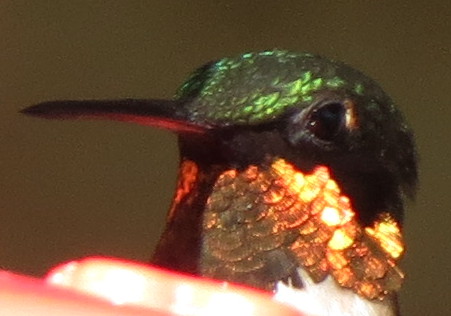
~ ~ ~
A wee bit on feeding hummingbirds...
If you really care about the best for your birds, lose the premade boxed mixes. They are a sales and marketing gimmick. The best the thing you can feed them is 4 parts water to 1 part SUGAR (1 cup sugar to 4 cups of water) which most closely exactly duplicates real actual nectar found in flowers. No un-compensated pro or expert uses the pre-made mixes. Never use honey, they can not process it. Clean your feeders weekly or so with 10% bleach solution, or anytime you see the dreaded black mold. Hang them in a shady spot so the fluid keeps longer in summer. Use a 1-2" wide band of tanglefoot high on the hanger as close to the top as possible (away from the feeder) to keep ants off the feeders. Never put out refrigerated fluid, always warm to outdoor ambient or room temp first. Do not leave feeders up past mid-October if you are not sure it will absolutely positively have (unfrozen) fluid every day all winter. Plant red native flowers like Red Turks Cap and Tropical Sage. A patch of either is magic, both is better.
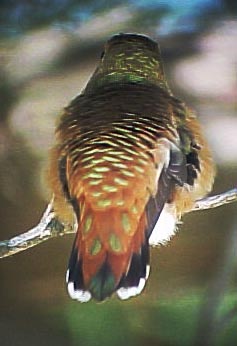
Rufous Hummingbird
Lighting is everything with hummers, a change of angle and
colorless dark can become a luminescent iridescent color show.
The end.
There will be more hummingbird photos added to this page in the future!
To see more worse hummingbird photos (like if you can't sleep) visit this page with some additional pictures:
Harbor Park Pages
Go to the bird photos page, and then to Hummingbird photos page.
~ ~ ~ ~ ~ ~ ~
If you have arrived here from our Bird Photos page, you may close your browser to return to the Bird Photos index.
Other visitors may click your "Back" button on your browser or select a link to keep visiting!
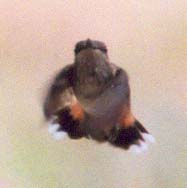
To Bird Photo Main Menu
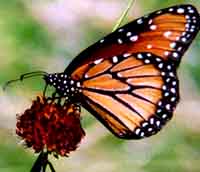
To Butterfly Pics
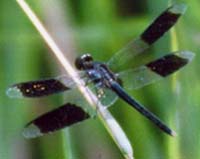
To Dragonfly & Damselfly Pics
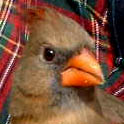
To Current Bird News
Birds
Utopia Birds
Birding Sites
Bird List
Bird Guide
Reports from Lost Maples
Winter Bird Count
Butterflies
Butterfly News
Butterfly List
Butterfly Photos
Rare Butterflies
Dragonflies
Critters, Bugs, & Stuff
Lost Maples
Garner State Park
Local Site Guide
Home
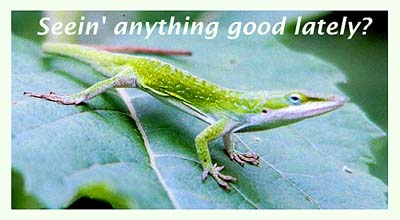
Our E-mail
mitch @ utopianature.com
 All photographs within this site are copyrighted
All photographs within this site are copyrighted